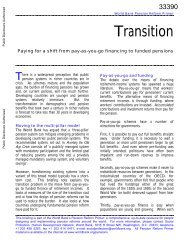Financial Sector Development in Africa: Opportunities ... - World Bank
Financial Sector Development in Africa: Opportunities ... - World Bank
Financial Sector Development in Africa: Opportunities ... - World Bank
You also want an ePaper? Increase the reach of your titles
YUMPU automatically turns print PDFs into web optimized ePapers that Google loves.
The Potential of Pro-Market Activism for F<strong>in</strong>ance <strong>in</strong> <strong>Africa</strong>: A Political Economy Perspective 187<br />
(<strong>World</strong> <strong>Bank</strong> 2005, 165). In some countries, such as Ghana or Nigeria,<br />
sectoral lend<strong>in</strong>g requirements were on the books, but not applied effectively<br />
(Daumont, Le Galle, and Leroux 2004, 25). However, there are<br />
examples of successful directed credit programs, although most of them<br />
are from East Asia (Stiglitz and Uy 1996; Vittas and Cho 1996).<br />
Another common tool used to broaden access to f<strong>in</strong>ance <strong>in</strong> rural areas<br />
was to compel banks wish<strong>in</strong>g to expand their networks of urban branches<br />
to also set up branches <strong>in</strong> rural areas. A prom<strong>in</strong>ent example is the Indian<br />
experiment of the late 1970s and 1980s, where the government imposed<br />
the so-called 1:4 license rule. This rule stated that banks could open one<br />
branch <strong>in</strong> an already-banked location only if they opened four <strong>in</strong><br />
unbanked locations (Burgess and Pande, 2005). Other countries where<br />
rural branch<strong>in</strong>g legislations were <strong>in</strong> place <strong>in</strong>clude Botswana, Nigeria, and<br />
Zambia (Brownbridge, Harvey, and Gockel 1998).<br />
The effectiveness of such legislation has been mixed at best. In<br />
Botswana and many other countries where rural branch<strong>in</strong>g legislation was<br />
tried, it was not enforced effectively (Brownbridge, Harvey, and Gockel<br />
1998; Daumont, Le Galle, and Leroux 2004). While the prom<strong>in</strong>ent rural<br />
branch expansion program <strong>in</strong> India term<strong>in</strong>ated because of high bank loan<br />
default rates, it is also regarded as one of the success stories: the rule not<br />
only caused banks to open relatively more rural branches <strong>in</strong> Indian states<br />
with lower <strong>in</strong>itial f<strong>in</strong>ancial development and broadened access to f<strong>in</strong>ance,<br />
but also significantly reduced rural poverty (Burgess and Pande 2005).<br />
The “modernist” period. Although some examples of market-replac<strong>in</strong>g<br />
activism were successful, <strong>in</strong> most cases it was not and might even have<br />
impeded development. From the 1970s onward, it was <strong>in</strong>creas<strong>in</strong>gly<br />
accepted that two major assumptions of the market-replac<strong>in</strong>g approach—<br />
that governments know how to replace markets and that they always<br />
seek to maximize social welfare—were flawed. A grow<strong>in</strong>g body of work<br />
found that public authorities <strong>in</strong> develop<strong>in</strong>g countries often had limited<br />
technical capacities for runn<strong>in</strong>g f<strong>in</strong>ancial <strong>in</strong>stitutions and that their will<strong>in</strong>gness<br />
and capacity to govern f<strong>in</strong>ancial <strong>in</strong>stitutions <strong>in</strong> a way that<br />
<strong>in</strong>creases private <strong>in</strong>vestment depended on the <strong>in</strong>terests of the political<br />
leadership (Brownbridge, Harvey, and Gockel 1998).<br />
In response to these <strong>in</strong>sights, a consensus emerged <strong>in</strong> the 1980s that<br />
governments should withdraw from markets, <strong>in</strong>clud<strong>in</strong>g the f<strong>in</strong>ancial sector.<br />
The costs of government failures were regarded as exceed<strong>in</strong>g those of<br />
market failures, and direct government <strong>in</strong>terventions were therefore seen<br />
as counterproductive. The new benchmark became the best-practice







